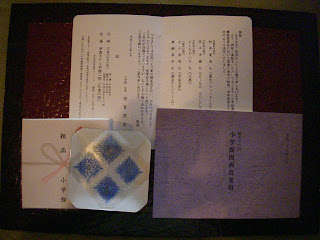During a trip to Fukuoka, I spotted an interesting monument. Fukuoka is located in southeast Japan, and is one of the seven major cities of the country.
"The place of invention of Sazae-san"
Sazae-san is one of Japan’s most respected four frame comics, and it has won its author Machiko Hasegawa the People’s Honor Award.
“Sazae-san” is the name of the series’ leading character: a house wife whose husband Masuo-san, son Tara-chan, brother Katsuo, sister Wakame, mother Fune and father Namihe, all live under the same roof. Such arrangement of course is considered rare in modern day Japan.
The names of the family members each have an sea-related origin:
Sazae-san: “sazae” means turban shell
Masuo-san: “masu” means trout
Tara-chan: “tara” means cod
Katsuo: “katsuo” means bonito
Wakame: “wakame” means seaweed
Fune: “fune” means boat
Namihe: “nami” means wave
Each episode is made up just four frames, illustrating the misadventures of Sazae-san and her family. As its animated series has been broadcasted on television for 50 years, the fact that the comic was first published by Asahi Shimbun is seldom known today. Initially, Sazae-san was published by a local evening newspaper in Fukuoka called Yukan Fukuichi in 1946. The comic was then acquired by Asahi Shimbun. Originally from Saga in Kyushu, Machiko Hasegawa spent her high school years in Fukuoka, then moved to Tokyo, but when war broke she returned to Fukuoka where she debuted with Sazae-san. A simple “home of Sazae-san” is seemingly more appropriate than the awkwardly worded “Place of invention of Sazae-san.” But perhaps it has something to do with Machiko Hasegawa’s notoriously particular copyright policies.
Sazae-san was first serialized after Japan’s defeat, which was more than sixty years ago. The eccentric hair dressing Sazae-san and Wakame may seem unusual today, but in fact they were right on trend back in the day. Fune’s white apron, worn over her kimono is called a kappogi, and Namihe’s felt hats as well as Masuo’s round glasses were rather fashionable at the time.
Today, four-frame comics are still serialized in most newspapers. Japan’s leading newspaper, Asahi Shimbun publishes Ishii Hisaichi’s Nono-chan (Tonari no Yamada-kun) in its morning paper, and in the evening Shiriagari Joji’s “Chikyu boeika no hitobito” (currently on break) takes the stage. The bestselling newspaper Yomiuri Shimbun publishes Masashi Ueda’s Kobo-chan.
A deal with a large newspaper is a great honor for these authors, as not only do they receive immense publicity, but for most authors the contract is literally permanent, meaning, they are rarely replaced unless the author wants to. Comics are easily serialized for 20 to 30 years, and many authors literally take them to their grave. And needless to say, they are paid rather generously.
Despite its popularity today, the four-frame comic suffered during the seventies, when the gekiga genre dominated the scene. It became all about realism, storyline and drama, meaning that longer comics were now in, and four-frame comics were so out that they practically became extinct.
Enter Ishii Hisaichi and the comic world saw the drama they wanted, but in the form of audiences’ responses to Ishii’s four-frame comic “Baito-kun.” “Baito-kun,” which roughly translates to “part timer,” is about a young man who, amidst the height of the student movement, shows an utter lack of interest in politics, and spends his days at various part-time jobs. It was published in a local job hunting magazine in Osaka. The comic was full of nonsense humor, and completely ignored the concept of four-frame comics through excessive dialogue.
The comic was self-published, and the "new" four-frame comic became a hit. This wasn't only a comeback - the until then "tedious" four-frame comic revolutionized the entire comic industry.
The first to notice this new talent was Futabasha, giving Ishii a serial comic deal with Weekly Manga Action. This was Ganbare!! Tabuchi-kun!!, a series of the hilarious misadventures of a baseball player modeled on Koichi Tabuchi . Ishii's success continued as he challenged various genres, from the historical Ninja Mugeicho to sci-fi Chiteijin.
Next emerged Masashi Ueda. His Furiten-kun, which was about a lazy and immature business man whose daily routines involved setting up childlike pranks around his office. The hilariously genius "prank ideas" captivated its audience, and soon other successful comics followed, such as Kariage-kun and Otoboke kacho.
Ishii and Ueda's success began a new trend, and suddenly, young authors such as Mikio Igarashi, Shigeki Ando, Koji Aihara, and Sensha Yoshida emerged. This is known as the golden age of four-frame comics, and today these authors are published in major newspapers. Yet the strict policies of these newspapers mean that the comics are moderated, so many of today's generation have only seen a flash of the original. As the years go by, four-frame comics are becoming less and less popular. Perhaps the industry is ready for another revolution. It has been thirty years since Ishii, after all.








